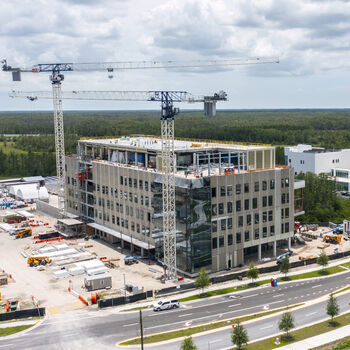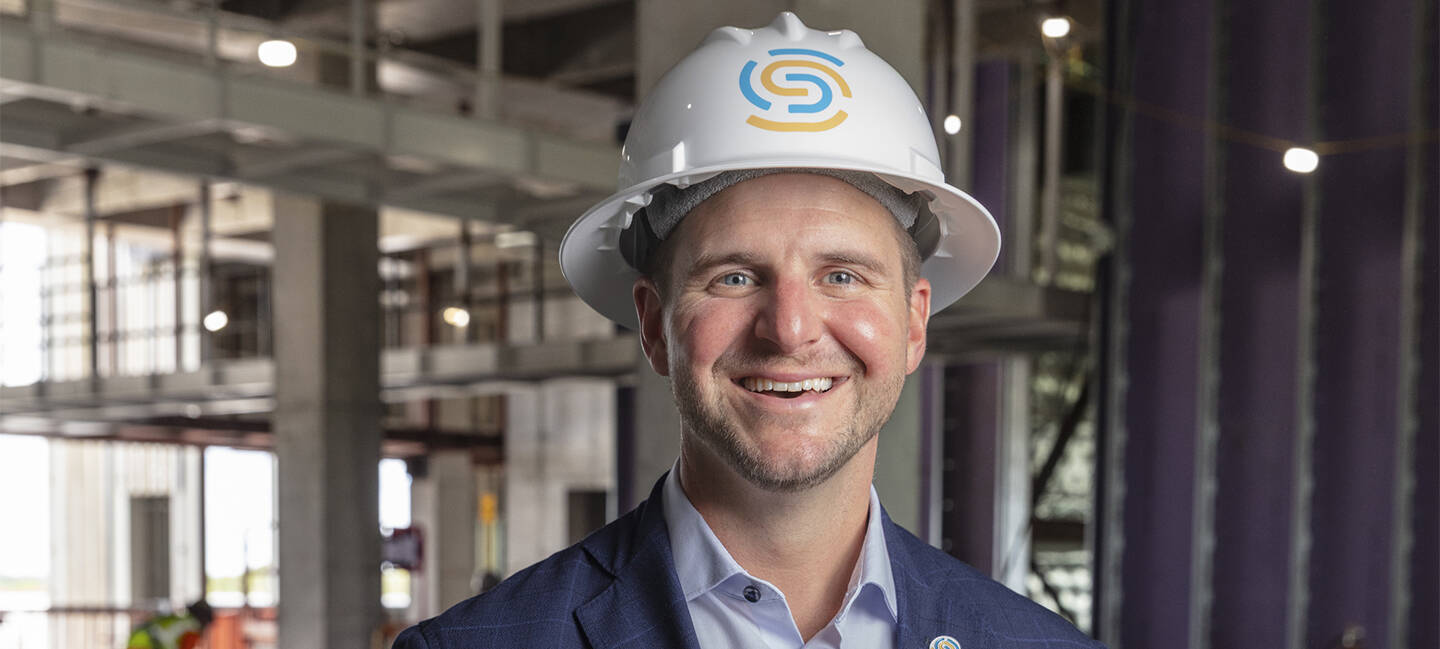Welcoming Speros President Josh Carpenter, DPhil
Josh Carpenter, DPhil, joined Moffitt Cancer Center in April 2025 as the president of Speros and the center’s first chief integration officer. Carpenter is tasked with guiding one of the most ambitious life sciences initiatives in the nation: transforming 775 acres in Pasco County from a former cow pasture into a world-class ecosystem for innovation, discovery and healing.
Carpenter is driven by the opportunity to close the historical gaps in the drug development pipeline, where research, manufacturing and treatment have often occurred continents apart, far removed from the patients they’re meant to serve. Under his leadership, Speros is narrowing that distance by creating a single, integrated environment where discovery, development and delivery happen side by side. He’s helping Moffitt build a community where science happens with patients, not to them, and where every partnership and design choice is intentional.
What drew you to Moffitt?
Everyone says the Moffitt mission is what drew them here, and that’s absolutely true. But for me, it’s also about a deeper sense that science is incredibly close to some major breakthroughs. New technologies and new modalities for treating and diagnosing cancer are emerging at a rapid pace. Moffitt has an integrated set of domain-specific experts across clinical and translational research, and it’s been building that strength, particularly in areas like cell therapy, for decades.
What we have at Speros is the opportunity to deepen that expertise while also pushing into new strategies and new areas where we can make a real difference in people’s lives. I wanted to be at a place on the vanguard of scientific research that truly has meaning for patients and, ultimately, for the future of humanity. Moffitt is the place where those breakthroughs are going to happen.
Can you tell us about your role as Moffitt’s first chief integration officer?
A big part of what I’m doing as chief integration officer is bringing Moffitt’s clinical and research strategies together toward specific aims that deliver better outcomes for our patients. There’s this liminal space between research and clinical care, and there’s so much potential there. Compressing the time it takes to move discoveries from the lab to the bedside is critical for patients who may not have time to wait for the right cure. What I love about Moffitt is how it creates real pathways for clinical trials, giving researchers and clinicians the chance to collaborate with industry sponsors and accelerate therapies that are truly on the cutting edge.
At Speros, that means thinking about infrastructure, whether it’s physical space, digital platforms, or land and building development. It also means looking ahead and asking how we integrate emerging technologies. All of this shapes how we’re building Moffitt’s future, not just for today, but for 20 years from now.

Speros marked major milestones in fiscal year 2025 with the topping out of the Moffitt Discovery and Innovation Center and the arrival of the proton therapy cyclotron from Belgium.
What were the major milestones for Speros in fiscal year 2025?
Over the past year, Speros has evolved from a greenfield site into a vibrant, rapidly developing research campus. We marked major milestones in April 2025 with the topping out of the Moffitt Discovery and Innovation Center and the arrival of our proton therapy cyclotron from Belgium.
Untouched just five years ago, the land now has over $600 million in active infrastructure and a growing team laying the foundation for world-changing science. Supported by state, local and federal leaders, and propelled by global outreach efforts, Speros is gaining momentum as a biotech destination. Our efforts have positioned it as Florida’s “moonshot” for life sciences, a place where discovery, development and delivery of care can happen in one ecosystem.
What will make Moffitt’s proton therapy at Speros different from others offered locally and across the state?
Moffitt’s proton therapy will be different because it is deeply integrated into our model of personalized, disease-specific care. Our radiation oncologists are embedded in every disease program at Moffitt. Each patient case is discussed in a multidisciplinary tumor board and tailored to their unique medical needs. That integrated, team-based approach ensures that proton therapy is not just a technology we offer. It’s a tool applied with precision, informed by deep expertise and driven by a mission to provide the best possible outcome for every individual.
What’s next on the horizon for Speros?
Over the next year, the campus will celebrate four grand openings including the Moffitt Speros Outpatient Center in January 2026, the Richard M. Schulze Family Foundation Proton Center in May 2026, the Moffitt Discovery and Innovation Center in summer 2026 and the CRYOGENE biorepository opening in fall 2026.
Right now, we’re focused on building the three P’s: people, partners and place. First, it’s about the people: Who’s going to be out there, who’s doing the work and who’s driving the science forward. Then, it’s about the partners: Those who will help propel that progress, whether they’re from academia, industry or government.
Finally, it’s about the place: What kind of physical and intellectual environment are we building to bring all of that together.
Speros gives Moffitt and Tampa a true “right to win” as global leaders in next-gen drug development by harnessing the power of proximity, especially for treatments like radiopharmaceuticals, where every distance matters. With ultra-short half-lives, these therapies demand research, production and care all in one place. That means colocating talent like radiochemists and clinicians, building infrastructure like new cyclotrons, and designing a walkable, connected campus that sparks collaboration. At its core, Speros is about creating a place where research isn’t done to patients, but with and for them, through thoughtful partnerships, intentional design and a united sense of purpose.




